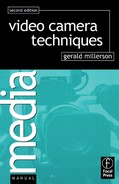As an audience watches the screen, they see a sequence of carefully selected intercut pictures telling a story. But if the show you are working on is shot out of final order, you may have little idea how your particular shots are going to be edited into this complex jigsaw puzzle.
A well-made show has continuity of styles and techniques. Even where shots have been taken on different occasions or by different people, they need to intercut as a smooth-flowing continuous effect.
In a multi-camera crew, individuals have to rely on the director’s guidance to ensure that their shots blend with others. Otherwise, left to themselves, a crew might choose excellent but almost identical shots, or present unrelated pictures that would not intercut successfully.
Whenever cameras are shooting similar subjects, it is possible to get some very strange effects when intercutting between them. Switching between differently-sized pictures of people, can cause them to ‘grow’ or ‘shrink’ on the transition. Mix between similar shots of two people, and you produce astonishing ‘Jekyll and Hyde’ transformations. Fine when you want that effect, but otherwise it can be quite distracting!
It is important to maintain consistent headroom. When it differs noticeably in successive shots, or when the camera heights vary, the visual jumps on cutting can be visually disturbing.
Although these are mainly matters for the director to worry about, you do need to be aware of them, so that your shots fit in with those from other cameras.
There are situations where you want to match your shot as accurately as possible to another camera’s, so that the two pictures combine very exactly. If for example one camera is showing a map, and another has a graphic of town names which are later faded up and superimposed. Or again, in a combined shot, where one camera shows a choir, while another has a small localized insert of a soloist. If they are mismatched, the result could be disastrous.
Many video cameras have a mixed feeds switch which allows you to superimpose another selected camera’s shot onto your own viewfinder picture. You can then adjust your framing and image size to make the two shots match. Without this facility, you would need to watch a combined picture on a nearby studio picture monitor, or be guided into position from the production control room.
Accidental effects
As the director cuts from one picture to another, visual mismatching can create disturbing effects.
1. Height jumps. Caused by mismatched lens heights that have no dramatic purpose.
2. Headroom changes. Shots have different amounts of headroom.
3. Size jumps. If the subject changes size slightly on a cut, it creates the effect of instant growth or shrinkage.
4. Transformations. If shots are very closely matched, one person can seem to become transformed to another on the cut!

